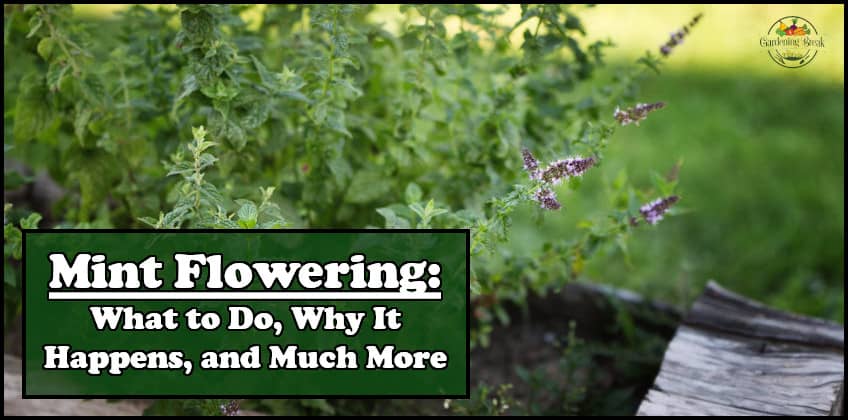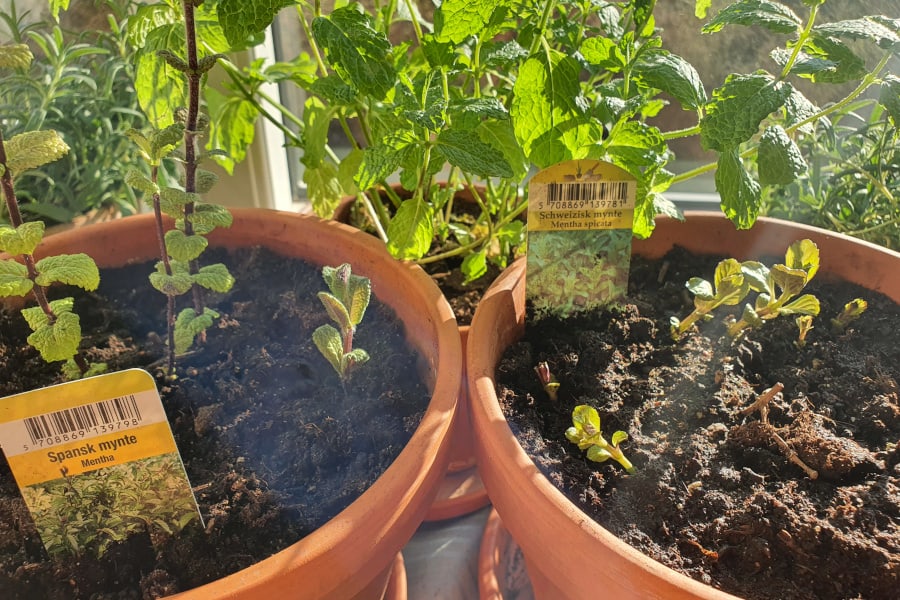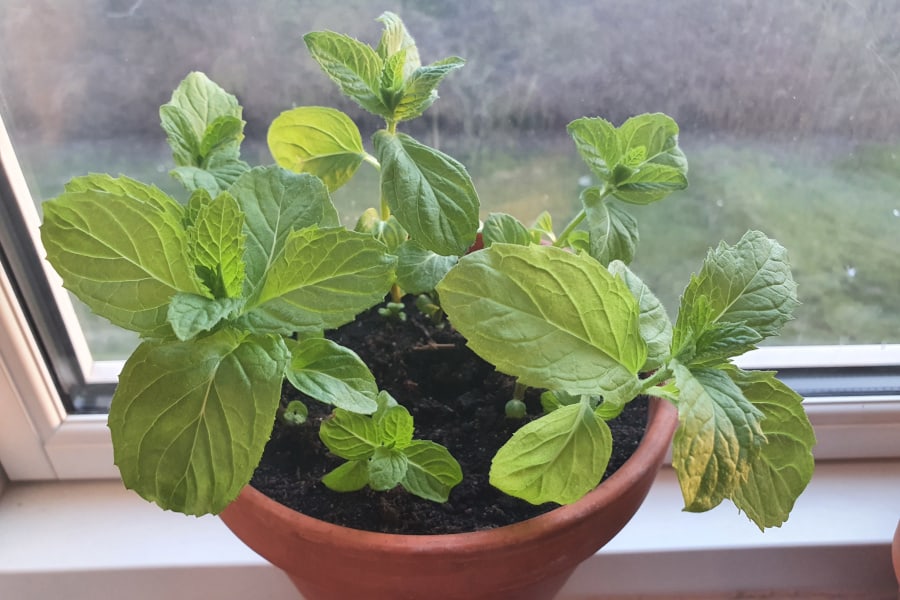This post contains affiliate links.
Mint plants produce some beautiful purple, pink, or white flowers, but do you need to do anything when your mint is flowering, and if so, what? The answer is a bit nuanced and depends on a couple of things. Here is what you should know.
When mint is flowering, you can either just let it flower or remove the flowers by cutting them off. Removing the flowers will keep the plant in the growing stage and allow you to harvest for longer. Letting the plant flower will slow its growth but attract some insects that benefit your whole garden.
Below, I present a bunch of examples of when either is the best thing to do, so you can find out what to do in your specific situation. I also cover a lot of other aspects of mint flowering, such as why and when it happens, whether mint is still as good to use after it flowers, and how to promote flowering.

What to Do When Mint Is Flowering (2 Easy Options)
When your mint plant is flowering, you essentially have two options. You can either let it flower or you can stop it.
First of all, I will tell you that you can’t really do it wrong, so don’t worry. You can let your mint flower, or you can remove the flowers, and regardless of what you choose to do, your mint plant will most likely be just fine. That being said, you should know that what you do when your mint is flowering affects how it develops and behaves for the rest of the growing season.
The best option for most people when their mint is flowering is to stop it from doing so as that keeps the plant growing and producing leaves for longer instead of focusing its energy on flowering.
But that doesn’t mean that it is the right thing to do for you. Let’s find out.
To make it as easy as possible for you, I have made a table with examples of situations when it is best to let mint flower and when it is best to stop it from flowering.
| Remove the flowers from your mint if: | Allow your mint plant to flower if: |
| You want to be able to harvest as many leaves as possible | You want to attract bees and other good insects to your garden for pollination |
| You want the plant to continue growing bigger | You don’t or rarely harvest and use the leaves |
| You prioritize having beautiful flowers over being able to harvest as many leaves | |
| You want to use or eat the flowers (in that case, harvest them when they are at the point you want) | |
| You want to collect seeds |
After writing this, I realize that I could come up with a lot more reasons for letting mint plants flower than for stopping it. That said, the two arguments for stopping it from flowering are very strong. At least in my opinion, but you should decide which arguments are most important to you and just follow that.
If you have decided that you want to stop your mint from flowering so you can harvest as many leaves as possible throughout the season, I recommend that you read this article where I explain the best harvesting methods for maximizing how much mint you get from your plants. With the methods I explain in that article, you delay flowering for as long as possible.
If you are still not sure what to do
In my opinion, the primary thing you have to decide if you are still not sure what to do when your mint is flowering is how important it is for you to be able to keep harvesting leaves. When mint is flowering, it doesn’t grow and produce leaves at nearly the same rate as before it started flowering.
- Remove the flowers as soon as they appear if you want to be able to harvest more leaves for a longer time.
- Allow your mint to flower if you don’t use a lot of the leaves or would like colorful flowers that attract bees and other good pollinating insects.
You should also know that unlike some other popular herbs, such as most basil varieties, mint is a perennial herb which means it can live for multiple years (read more). So unlike those other herbs, flowering does not indicate that mint is nearing the end of its life but merely that it is now at that stage of its annual cycle.
I personally like to have multiple mint plants at the same time. That way, I can let some of them flower and attracts bees and other good pollinating insects, and I can stop some of them from flowering so I can harvest as much as possible from them. If I only had one mint plant, I would most likely stop it from flowering so I could harvest as much as possible from it.
Since most people probably want to be able to harvest as many leaves for as long as possible, I will explain the best way to do that now. After that, I explain how to promote flowering for those of you that want that.
Easiest and Safest Way to Stop Mint From Flowering

If you use the wrong technique for removing mint flowers, you risk introducing pests and diseases or otherwise damaging the plant. Here is how to do it right.
The best and easiest way to remove mint flowers is to use clean and sharp pruning shears to make a diagonal cut about 1-2 inches (2.5-5 cm) below the flower or flower bud. Remove flowers or flower buds as early as possible to keep the plant in the growing and production stage for as long as possible.
You can sometimes also just pinch off the flowers with your fingers or nails, but there is a higher risk of damaging the plant than if you use pruning shears. Especially if the flowers have been there for a few days and the stem has gotten a bit thick and hard to break.
Using pruning shears also reduces the risk of pests and diseases as they can make a much cleaner cut. That’s why I always recommend using some good pruning shears. You can buy decent pruning shears pretty cheaply if you don’t already have some. I recommend these since I have them myself and I love them.
If your mint has started flowering and you have decided to remove the flowers, it might be a good idea to give it a full pruning while you are at it, as that further delays flowering and encourages fresh and green growth. I have a full explanation and guide for that here.
A more long-term way you can keep your mint from flowering for longer is to keep it in a partly shaded area instead of in full sun. It likely won’t grow and produce leaves as fast, but it will also go for longer without flowering, as temperature and direct sunlight both play a big role in that.
How to Make Your Mint Flower Faster (5 Tips)
There are several reasons why you might want to help your mint start flowering faster. Mint flowers not only look beautiful but also attract bees and other insects that help pollinate flowers, thereby playing an important role in the production of fruits, vegetables, and seeds.
Here are some tricks you can use to promote flowering and make your mint flower faster.
- Fertilize your mint with a phosphorous-rich fertilizer.
- Place your mint in a warm spot.
- Place your mint in full sun.
- Water your mint whenever the top inch of the soil is dry.
- Grow your mint in well-drained and nutrient-rich soil.
I found this really cool video on Youtube that shows just how effective mint flowers are at attracting good insects. I share some more details on the five points below the video, but if you have 2 minutes, I recommend watching the video first, because it is pretty cool.
According to Fine Gardening, phosphorous supports the development of roots, stems, blossoms, and fruits. They write that a fertilizer mix like 15-30-15 is good for boosting flower production.
15-30-15 refers to the NPK-value, which is the ratio of the three nutrients nitrogen, phosphorus, and potassium in the fertilizer. To promote flowering, get a fertilizer with a high content of phosphorus (P). It doesn’t have to be exactly 15-30-15, but close to that would probably be optimal.
The temperature and level of direct sunlight especially play big roles when it comes to flowering. The warmer it is, the faster mint will flower.
The four last points, temperature, sunlight, watering, and soil, fall under the category of growing conditions. I have another post where I cover these as well as some other important growing conditions in detail to teach you how to provide the best conditions for your mint.
Signs Mint Is About to Flower
It can be very useful to know when mint is about to flower, whether it is because you want to stop it as early as possible or because you are excited about the colorful flowers and the helpful insects they attract.
Here are some signs that your mint might be about to flower.
- The plant is growing and producing leaves at a slower rate than before.
- New leaves are small and don’t get as large as the older ones.
- Small flower buds begin to appear around the plant at the end of new shoots.
Stunted growth and small leaves can also be caused by other things, so the only way you can be confident that your mint is about to flower is when you see the small flower buds appearing around the plant.
Why Your Mint Is Flowering

The simplest explanation of why plants flower is that they are getting ready to finish their reproductive cycle by producing seeds. The flowers are essentially the reproductive organs of the plant and the seeds are the offspring.
Flowering is a natural part of mint plants’ annual cycle. It usually happens in the summer when the temperature is high, and there is a lot of direct sunlight, but stress-induced flowering can also happen because of poor growing conditions.
It is usually a good sign if your mint is flowering. It usually means that you’re doing things right. However, it can also mean that your mint plant is under stress for whatever reason, which causes it to flower early in an attempt to finish its reproductive cycle.
If you don’t prune your mint or haven’t done so in a while, it is also much more likely to begin flowering. Pruning or frequent harvesting not only delays flowering but is also a way to make your mint much bushier and more productive. I explain this and a lot of other tips for making your mint bushier and more productive in this guide.
Does Mint Die After It Is Done Flowering? Explained
For a lot of plants, flowering marks the end of their lifecycle, but what about mint? Does mint die after it is done flowering?
Mint does not die after it is done flowering. Mint is a perennial herb, which means it can live for multiple years. Mint stems and leaves may begin to wither and die back once the flowering process is over, but after some time, new stems and shoots will begin to grow from the roots.
It might seem like your mint is dying when it starts withering towards the end of the year (or it might not wither at all depending on where you live), but chances are your mint is perfectly fine even if the green growth dries up. The plant’s roots are protected by a layer of soil, which almost always allows them to live through the winter and produce new green growth once it gets warmer.
Can You Still Use Mint That Is Flowering? Yes, But…

If your mint is flowering, you might be wondering if it is still good to use or perhaps even if you can use the flowers for anything. Here is what you should know.
Mint can still be harvested and used when it is flowering. The flowers are also edible and have a similar taste as the leaves, although they are often a bit milder. Depending on which mint variety you have, they might have notes of licorice, apple, lemon, or something else.
Some people say that mint leaves taste no different when the plant is flowering, and some people say that the leaves lose some of their taste. My experience is mixed. Sometimes I agree that they might taste a bit milder, but sometimes I honestly can’t taste the difference at all. If you make sure to remove the flowers as soon as they appear, the leaves’ taste and smell shouldn’t be affected.
Something important you should know is that flowering mint plants don’t produce leaves at nearly the same rate as when they were not flowering, so you won’t be able to harvest as much.
What Time of the Year Does Mint Typically Flower? Explained
Mint is a very versatile herb that behaves differently depending on where it is grown. That is also true when it comes to flowering, but when can you expect your mint to flower? Here is what you should know.
Mint can flower at different times of the year, depending on where you live. The warmer it is, the more likely mint is to begin flowering, so it is most common for mint to flower towards the end of the summer.
That said, mint can flower between June and September, according to Bonnie Plants.

